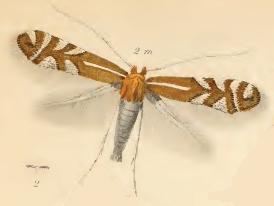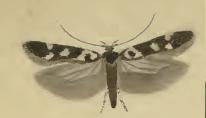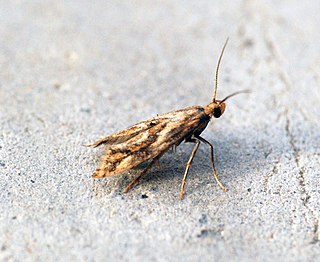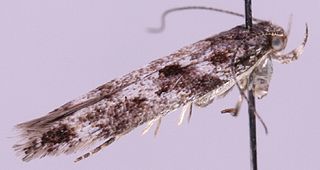
Phyllonorycter junoniella is a moth of the family Gracillariidae. It is known from all of Europe, except Ireland, the Iberian Peninsula and the Balkan Peninsula.

Caloptilia betulicola, the red birch slender, is a moth of the family Gracillariidae. It is found from Scandinavia and the north of European Russia to the Pyrenees and Alps and from Ireland to Poland and Slovakia. In the east it is found up to China, Japan and the Russian Far East.

Caloptilia semifascia is a moth of the family Gracillariidae. It is known from most of Europe, except the Iberian Peninsula, Ireland, Iceland and the western part of the Balkan Peninsula.

Elachista adscitella is a moth of the family Elachistidae found in Europe.

Elachista chrysodesmella is a moth of the family Elachistidae. It is found from Sweden to the Iberian Peninsula, Italy and Romania and from France to Russia and Ukraine.

Elachista bedellella is a moth of the family Elachistidae found in Europe.

Elachista dispunctella is a moth of the family Elachistidae. It is found in most of Europe, except most of the Balkan Peninsula, Fennoscandia, the Benelux, Portugal, Great Britain, Ireland and Iceland.

Caryocolum vicinella is a moth of the family Gelechiidae. It is found in most of Europe, eastwards to the southern Ural.

Epermenia falciformis, also known as the large lance-wing, is a moth of the family Epermeniidae found in Europe. It was first described by Adrian Hardy Haworth in 1828.

Digitivalva arnicella is a moth of the family Acrolepiidae. It is found in Norway, Sweden, the Netherlands, Belgium, Denmark, Germany, France, Switzerland, Austria, Italy, Hungary, Slovakia, the Czech Republic, Romania, Poland and Lithuania.
Digitivalva perlepidella is a moth of the family Acrolepiidae. It is found in Great Britain, the Netherlands, France, Germany, Switzerland, Austria, Poland, the Czech Republic, Slovakia, Hungary, Croatia, Romania and Bulgaria.

Digitivalva valeriella is a moth of the family Acrolepiidae. It is found in Sweden, Denmark, Germany, France, Austria, Hungary, Romania, Slovakia, Poland, Lithuania, Latvia and Russia.

Digitivalva pulicariae is a moth of the family Acrolepiidae. It is found in most of Europe, except Portugal, Fennoscandia, the Baltic region and Poland.
Euhyponomeutoides ribesiella is a moth of the family Yponomeutidae. It is found in Fennoscandia, Germany, Poland, Estonia, Ukraine, Slovakia, Austria, Belgium and France.

Caryocolum petrophila is a moth of the family Gelechiidae. It is found in France, Italy, Austria, Switzerland, Estonia, Scandinavia, North Macedonia and Russia. It is also found in Turkey.

Caryocolum kroesmanniella is a moth of the family Gelechiidae. It is found from Fennoscandia to the Pyrenees, Alps and Romania and from Great Britain to southern Russia. The habitat consists of open woodland.

Exoteleia dodecella, the pine bud moth, is a moth of the family Gelechiidae. It is widely distributed from western Europe to Siberia. It is an introduced species in North America.

Bucculatrix absinthii is a moth in the family Bucculatricidae. It was first described by Anton Gartner in 1865. It is found in Europe, from Scandinavia to France and Italy and from Germany to Romania.
Bucculatrix argentisignella is a moth species in the family Bucculatricidae. It was first described by Gottlieb August Wilhelm Herrich-Schäffer in 1855 and is found in France and in disjunct populations in Central, Eastern and Northern Europe.

Bucculatrix noltei is a moth in the family Bucculatricidae. It is found from Finland to Belgium, Italy and the Crimea and from the Netherlands to Central Russia. It was described by August Arthur Petry in 1912.













